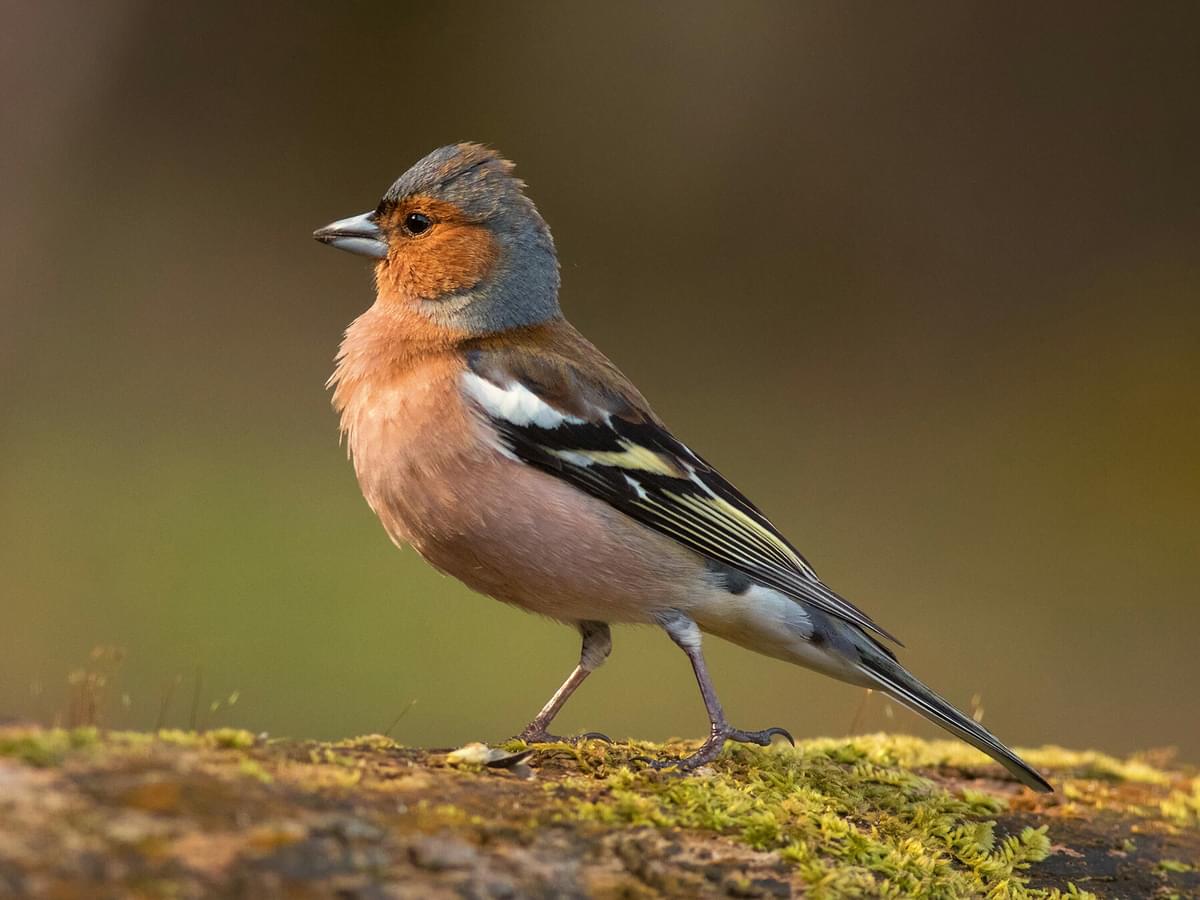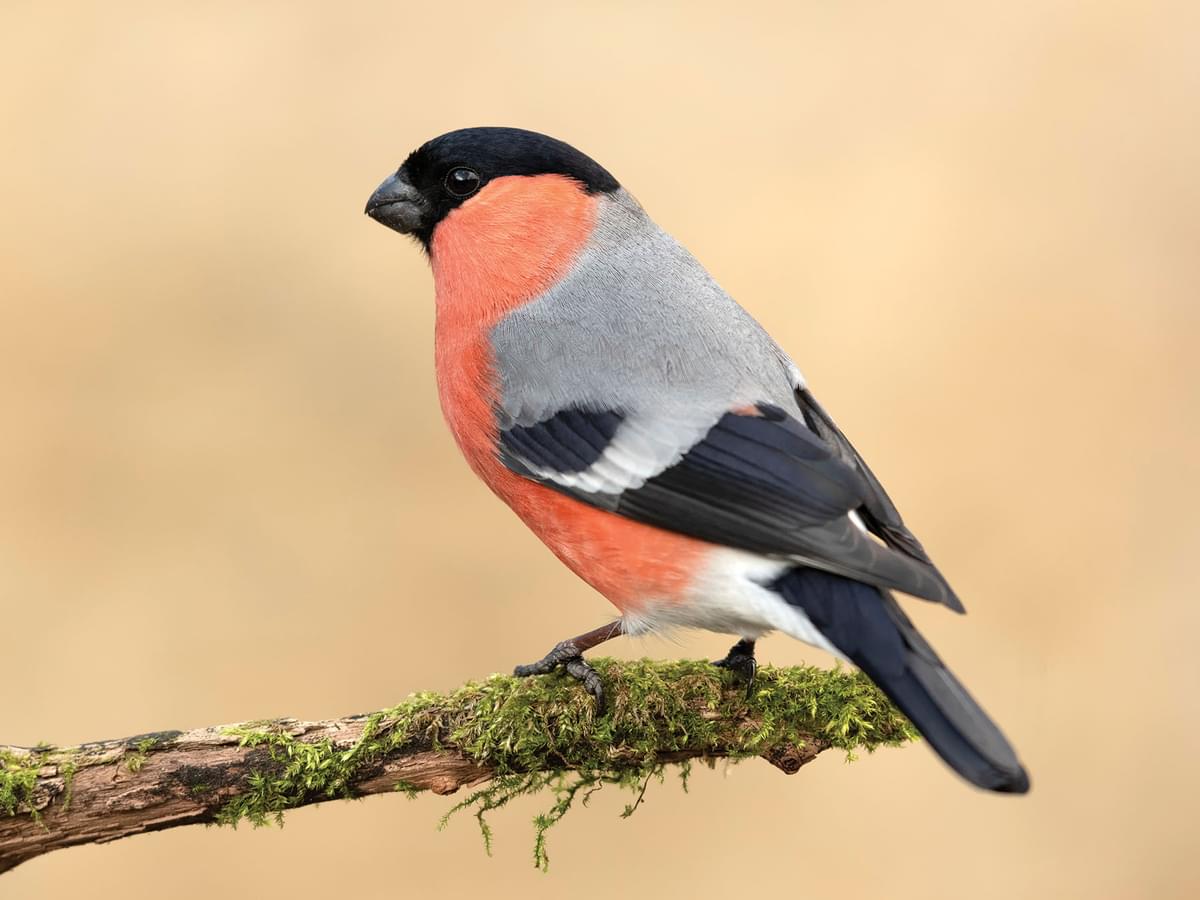The bullfinch (Pyrrhula pyrrhula) and chaffinch (Fringilla coelebs) are striking members of the finch family and are pretty abundant throughout most parts of Europe and Asia. These two species share much of the same habitat, so it's no wonder people can sometimes get confused with identification between the two. So, what are the differences between chaffinches and bullfinches?
The most notable difference between a chaffinch and a bullfinch is the overall shape of the bird. Bullfinches generally appear plumper and have a general rounder look to them.
Although both birds are finches, chaffinches tend to look more finch-like and have the typical seed-eater beak. Both these birds can have similar coloured plumages, but bullfinches appear more striking.
Continue reading for more differences and similarities between the common chaffinch and the Eurasian bullfinch below.

Common Chaffinch Male

Male Bullfinch
Comparison Table
| Feature | Bullfinch | Chaffinch |
|---|---|---|
| Size | Compact and stocky; length about 14-16 cm (5.5-6.3 inches) | Slightly larger; length about 14-18 cm (5.5-7 inches) |
| Weight | Average weight around 21-27 grams | Average weight around 18-29 grams |
| Appearance | Bright pinkish-red breast and cheeks in males | Males: Bluish-grey cap, rusty-red underparts |
| Females: More subdued grey-brown with a pinkish underwash | Females: More subdued, with greenish-brown tones | |
| Both sexes have a distinctive black cap | Both sexes show distinctive white wing bars | |
| Song and Calls | Soft, mournful call; less vocal than Chaffinch | Loud, cheerful song; distinctive "rain" call |
| Habitat | Prefers woodland, orchards, and large gardens | Common in woodlands, gardens, and parks; adaptable to various habitats |
| Distribution | Across Europe and parts of Asia | Widespread across Europe, parts of North Africa and western Asia |
| Breeding | Nests in dense shrubs or trees, often low to the ground | Builds cup-shaped nests in trees or shrubs, often at a higher elevation |
| Diet | Seeds, buds, and some insects | Seeds and insects, with a preference for seeds |
| Behaviour | Shy and elusive, often seen in pairs or small groups | Sociable and often seen in larger flocks outside the breeding season |
| Conservation Status | Least Concern, but some local declines reported | Least Concern, widespread and common |
| Identification Tips | Look for the bold black cap and bright underparts in males | Males are colourful with a distinct cap and underparts, white wingbars |
| Females are duller but still have the black cap | Females are more uniformly brown but with the same wing pattern |
Other Differences
Plumage
The plumage is another good way to differentiate between the two species; however, there is no straightforward answer. Both species have many subspecies that vary in the colour of their plumages, which we will go further into below.
Overall, bullfinches have a plumage that has more solid blocks of colour. This can vary per the subspecies, but one of the most known plumage is the male, who has an unmistakable vibrant pinkish-red breast. Female bullfinches have mostly grey plumages and are generally similar in size to males.
A notable difference between the bullfinch and chaffinch is the colour on the top of the head. Bullfinches have a dark black patch that covers the entire head to underneath the eye. This patch is well defined and is clearly broken up by the colour of the plumage below.
Chaffinches, on the other hand, have either lightish grey or buff coloured heads that don't usually extend under the eye.
On the wings, chaffinches have white detailing which stands out. Bullfinches don't have this, and instead, have more of a grey detail, although their wings are mostly black.

The lighter plumage of a female chaffinch

Female Bullfinch
Juvenile Bullfinches
Juvenile bullfinches can sometimes be confused with chaffinches, as before they reach their full, more striking plumage do tend to look quite a bit like a chaffinch.
The juvenile plumage of a bullfinch is similar to females, but they are generally more of a brown or dull brown colour on their upper parts.
The lack of the black marking that goes under the eye, is the main reason why it can be hard to tell the difference between a chaffinch.
The best way is to look at the wings, as chaffinches have much more white detailing compared to the more solid-black looking wings of a bullfinch.

A juvenile bullfinch
Beak shape
The beak shape is another good way to tell the difference, as the form is quite different.
Chaffinches have beaks that are much more similar to most seed-eating finches, like the goldfinch and greenfinch. Their bills are conical and are usually grey or darkish in colour. When compared to a bullfinch, they also appear much pointier and straighter.
The bill of a bullfinch is much broader and appears overall a much rounder shape and less pointy than the bill of a chaffinch.
Bullfinch
Pyrrhula pyrrhula

Length
14-16cm
Wingspan
22-26cm
Weight
21-27g
Song and call
Both sexes of the bullfinch sing (mainly the male though) and produce a soft and slow descending 'peu' or 'teu teu' sound, which has varying degrees of emphasis.
Male chaffinches are the only ones who sing and will primarily be heard between March and July throughout most of their range. The main song is a 'chip chip chip, tell tell tell, cherry-erry-erry tissi cheweeeoo' sound, that is a descending rattle of musical notes.
Bullfinch Call
Simon Elliott, XC602105. Accessible at www.xeno-canto.org/602105.
Chaffinch Call
Jack Berteau, XC671840. Accessible at www.xeno-canto.org/671840.
Habitats
These two birds are often misidentified because they tend to spend their time in pretty much the same habitat.
The habitat that chaffinches and bullfinches like are woodlands, parks, hedgerows and gardens in towns, villages and cities. Both birds are regular visitors to bird feeders and bird tables in gardens and will often be spotted feeding together.
Chaffinch
Fringilla coelebs

Length
14-16cm
Wingspan
24-28cm
Weight
18-29g
Size
On average, chaffinches tend to be slightly longer. This difference is usually only a couple of centimetres, so often won't be a viable way to tell the difference.
Bullfinches are heavier on average and have weights that range between 21 and 38 grams. Chaffinches have average weights between 17 and 29 grams.
As previously mentioned, bullfinches tend to look bulkier than chaffinches, so they often appear bigger.
Which Is More Common?
In the UK, you're much more likely to see a chaffinch than a bullfinch. This is because there are estimated to be over 6 million of these birds, whereas the bullfinch has a UK population estimated around 200,000.
In the UK, both species of these birds can be seen across the entire country, too, all year round as they are both resident species.
